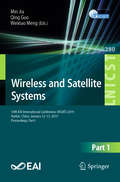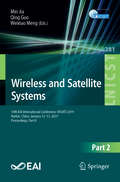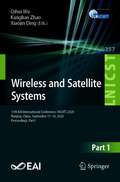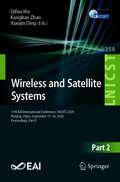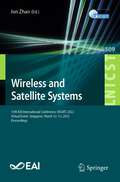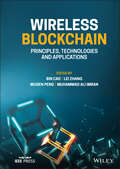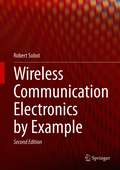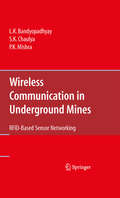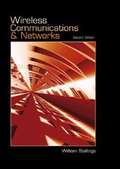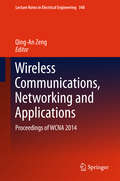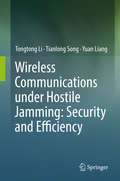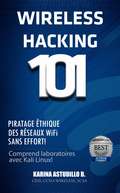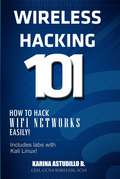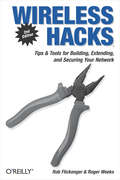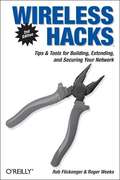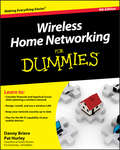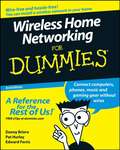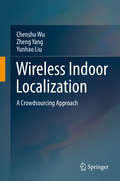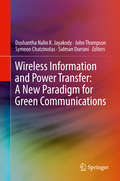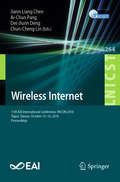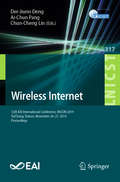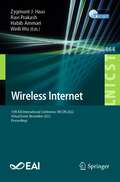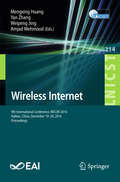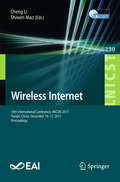- Table View
- List View
Wireless and Satellite Systems: 10th EAI International Conference, WiSATS 2019, Harbin, China, January 12–13, 2019, Proceedings, Part I (Lecture Notes of the Institute for Computer Sciences, Social Informatics and Telecommunications Engineering #280)
by Min Jia Qing Guo Weixiao MengThis two-volume set LNICST 280-281 constitutes the post-conference proceedings of the 10th EAI International Conference on Wireless and Satellite Services, WiSATS 2019, held in Harbin, China, in January 2019. The conference was formerly known as the International Conference on Personal Satellite Services (PSATS) mainly covering topics in the satellite domain. The 137 full papers were carefully reviewed and selected from 289 submissions. The papers are organized in topical sections on machine learning for satellite-terrestrial networks, human-machine interactive sensing, monitoring, and communications, integrated space and onboard networks, intelligent signal processing, wireless communications and networks, vehicular communications and networks, intelligent 5G communication and digital image processing technology, security, reliability and resilience in internet of things, advances in communications and computing for internet of things.
Wireless and Satellite Systems: 10th EAI International Conference, WiSATS 2019, Harbin, China, January 12–13, 2019, Proceedings, Part II (Lecture Notes of the Institute for Computer Sciences, Social Informatics and Telecommunications Engineering #281)
by Min Jia Qing Guo Weixiao MengThis two-volume set LNICST 280-281 constitutes the post-conference proceedings of the 10th EAI International Conference on Wireless and Satellite Services, WiSATS 2019, held in Harbin, China, in January 2019. The conference was formerly known as the International Conference on Personal Satellite Services (PSATS) mainly covering topics in the satellite domain. The 137 full papers were carefully reviewed and selected from 289 submissions. The papers are organized in topical sections on machine learning for satellite-terrestrial networks, human-machine interactive sensing, monitoring, and communications, integrated space and onboard networks, intelligent signal processing, wireless communications and networks, vehicular communications and networks, intelligent 5G communication and digital image processing technology, security, reliability and resilience in internet of things, advances in communications and computing for internet of things.
Wireless and Satellite Systems: 11th EAI International Conference, WiSATS 2020, Nanjing, China, September 17-18, 2020, Proceedings, Part I (Lecture Notes of the Institute for Computer Sciences, Social Informatics and Telecommunications Engineering #357)
by Qihui Wu Kanglian Zhao Xiaojin DingThis two-volume set LNICST 357-358 constitutes the post-conference proceedings of the 11th EAI International Conference on Wireless and Satellite Services, WiSATS 2020, held in Nanjing, China, in September 2020. The 91 full papers and workshop papers were carefully reviewed and selected from 200 submissions. Part I - LNICST 357 - details original research and results of wireless and satellite technology for a smarter global communication architecture. The theme of WISATS 2020 is “Intelligent Wireless and Satellite Communications for Beyond 5G”. Part II – LNICST 358 - presents 6 workshop papers: High Speed Space Communication and Space Information Networks (HSSCSIN); Integrated Space and Onboard Networks (ISON); Intelligent Satellite Operations, Managements, and Applications (ISOMA); Intelligent Satellites in Future Space Networked System (ISFSNS); Satellite Communications, Networking and Applications (SCNA); Satellite Internet of Things; Trusted Data Sharing, Secure Communication (SIOTTDSSC).
Wireless and Satellite Systems: 11th EAI International Conference, WiSATS 2020, Nanjing, China, September 17-18, 2020, Proceedings, Part II (Lecture Notes of the Institute for Computer Sciences, Social Informatics and Telecommunications Engineering #358)
by Qihui Wu Kanglian Zhao Xiaojin DingThis two-volume set LNICST 357-358 constitutes the post-conference proceedings of the 11th EAI International Conference on Wireless and Satellite Services, WiSATS 2020, held in Nanjing, China, in September 2020. The 91 full papers and workshop papers were carefully reviewed and selected from 200 submissions. Part I - LNICST 357 - details original research and results of wireless and satellite technology for a smarter global communication architecture. The theme of WISATS 2020 is “Intelligent Wireless and Satellite Communications for Beyond 5G”. Part II – LNICST 358 - presents 6 workshop papers: High Speed Space Communication and Space Information Networks (HSSCSIN); Integrated Space and Onboard Networks (ISON); Intelligent Satellite Operations, Managements, and Applications (ISOMA); Intelligent Satellites in Future Space Networked System (ISFSNS); Satellite Communications, Networking and Applications (SCNA); Satellite Internet of Things; Trusted Data Sharing, Secure Communication (SIOTTDSSC).
Wireless and Satellite Systems: 13th EAI International Conference, WiSATS 2022, Virtual Event, Singapore, March 12-13, 2023, Proceedings (Lecture Notes of the Institute for Computer Sciences, Social Informatics and Telecommunications Engineering #509)
by Jun ZhaoThis book constitutes the refereed post-conference proceedings of the 13th International Conference on Wireless and Satellite Services, WiSATS 2022, held in March 12-13, 2023. Due to COVID-19 pandemic the conference was held virtually. The 9 full papers were carefully reviewed and selected from 23 submissions. They were organized in topical sections as follows: Security and Privacy in Healthcare, Transportation, and Satellite Networks, Advanced Technologies in Wireless Communication Systems, Network Efficiency and Reliability.
Wireless Blockchain: Principles, Technologies and Applications (IEEE Press)
by Bin Caop>Explore foundational concepts in blockchain theory with an emphasis on recent advances in theory and practice In Wireless Blockchain: Principles, Technologies and Applications, accomplished researchers and editors Bin Cao, Lei Zhang, Mugen Peng, and Muhammad Ali Imran deliver a robust and accessible exploration of recent developments in the theory and practice of blockchain technology, systems, and potential application in a variety of industrial sectors, including manufacturing, entertainment, public safety, telecommunications, public transport, healthcare, financial services, automotive, and energy utilities. The book presents the concept of wireless blockchain networks with different network topologies and communication protocols for various commonly used blockchain applications. You’ll discover how these variations and how communication networks affect blockchain consensus performance, including scalability, throughput, latency, and security levels. You’ll learn the state-of-the-art in blockchain technology and find insights on how blockchain runs and co-works with existing systems, including 5G, and how blockchain runs as a service to support all vertical sectors efficiently and effectively. Readers will also benefit from the inclusion of: A thorough introduction to the Byzantine Generals problem, the fundamental theory of distributed system security and the foundation of blockchain technology An overview of advances in blockchain systems, their history, and likely future trends Practical discussions of Proof-of-Work systems as well as various Proof-of-“X” alternatives, including Proof-of-Stake, Proof-of-Importance, and Proof-of-Authority A concise examination of smart contracts, including trusted transactions, smart contract functions, design processes, and related applications in 5G/B5G A treatment of the theoretical relationship between communication networks and blockchain Perfect for electrical engineers, industry professionals, and students and researchers in electrical engineering, computer science, and mathematics, Wireless Blockchain: Principles, Technologies and Applications will also earn a place in the libraries of communication and computer system stakeholders, regulators, legislators, and research agencies.
Wireless Communication Electronics by Example
by Robert SobotThis book is intended for senior undergraduate and graduate students as well as practicing engineers who are involved in design and analysis of radio frequency (RF) circuits. Fully-solved, tutorial-like examples are used to put into practice major topics and to understand the underlying principles of the main sub-circuits required to design an RF transceiver and the whole communication system. Starting with review of principles in electromagnetic (EM) transmission and signal propagation, through detailed practical analysis of RF amplifier, mixer, modulator, demodulator, and oscillator circuit topologies, as well as basics of the system communication theory, this book systematically covers most relevant aspects in a way that is suitable for a single semester university level course. Readers will benefit from the author’s sharp focus on radio receiver design, demonstrated through hundreds of fully-solved, realistic examples, as opposed to texts that cover many aspects of electronics and electromagnetic without making the required connection to wireless communication circuit design.Offers readers a complete, self-sufficient tutorial style textbook;Includes all relevant topics required to study and design an RF receiver in a consistent, coherent way with appropriate depth for a one-semester course;Uses hundreds of fully-solved, realistic examples of radio design technology to demonstrate concepts;Explains necessary physical/mathematical concepts and their interrelationship.
Wireless Communication in Underground Mines
by P. K. Mishra L. K. Bandyopadhyay S. K. ChaulyaUnderground mines require fool-proof, mine-wide communication systems for smooth functioning of mine production and worker safety. Proper and reliable communication systems not only decrease machine break down time, but more importantly provide immediate transmission of messages from the underground working area to the surface for normal mining operations as well as necessary rescue operations in case of disaster. Therefore, a reliable and effective communication system is an essential requisite for safe working, and maintaining the requisite production and productivity of underground mines. Existing wired communication systems cannot reach parts of complex mines, and are ineffective in many disaster situations. Wireless Communication in Underground Mines focuses on the recent advancement in wireless communication technologies for underground mines and other hazardous areas. This comprehensive book provides a unified foundation of wireless communication systems for transmission of data, voice and video. The book also incorporates intrinsically safe design and development aspects of circuits, which are essential for underground mines and hazardous areas. The book consists of recent wireless communication technologies designed and developed by the authors for underground mines and draws upon their experiences in the fields. Wireless Communication in Underground Mines covers a wide range of the recent practices of wireless communication systems as well as wireless sensor networking, radio frequency identification devices, system specific embedded software, application software, and designing and developing techniques for intrinsic safe circuits.
Wireless Communications and Networks, Second Edition
by William StallingsWireless Communications and Networks, 2e, provides one of the most up-to-date and accurate overviews of wireless principles, technology, and application. It is ideal for courses in wireless networking, wireless communications, wireless data communications or wireless technology in departments of Computer Science, Engineering, IT, and Continuing Education. The rapid growth of mobile telephone use, satellite services, and the wireless Internet are generating tremendous changes in telecommunications and networking. Combining very current technical depth with a strong pedagogy and advanced Web support, this new edition provides a comprehensive guide to wireless technology--exploring key topics such as technology and architecture, network types, design approaches, and the latest applications.
Wireless Communications, Networking and Applications
by Qing-An ZengThis book is based on a series of conferences on Wireless Communications, Networking and Applications that have been held on December 27-28, 2014 in Shenzhen, China. The meetings themselves were a response to technological developments in the areas of wireless communications, networking and applications and facilitate researchers, engineers and students to share the latest research results and the advanced research methods of the field. The broad variety of disciplines involved in this research and the differences in approaching the basic problems are probably typical of a developing field of interdisciplinary research. However, some main areas of research and development in the emerging areas of wireless communication technology can now be identified. The contributions to this book are mainly selected from the papers of the conference on wireless communications, networking and applications and reflect the main areas of interest: Section 1 - Emerging Topics in Wireless and Mobile Computing and Communications; Section 2 - Internet of Things and Long Term Evolution Engineering; Section 3 - Resource Allocation and Interference Management; Section 4 - Communication Architecture, Algorithms, Modeling and Evaluation; Section 5 - Security, Privacy, and Trust; and Section 6 - Routing, Position Management and Network Topologies.
Wireless Communications under Hostile Jamming: Security and Efficiency
by Tongtong Li Tianlong Song Yuan LiangThis monograph is intended for the designers and would-be designers of secure and efficient wireless communication systems under intentional interference. Along with the widespread of wireless devices, especially reconfigurable software defined radios, jamming has become a serious threat to civilian communications. In this book, going beyond traditional communication system design that mainly focuses on accurate information transmission under benign environments, we aim to enhance the physical layer security of communication systems by integrating modern cryptographic techniques into transceiver design, so as to achieve secure high-speed transmission under hostile interference with high reliability and efficiency. We revisit existing jamming patterns, and introduce new jamming patterns. We analyze the weaknesses of existing anti-jamming techniques. We present innovative and feasible anti-jamming techniques, which can strengthen the inherent security of the 3G, 4G and the upcoming 5G systems with minimal and inexpensive changes to the existing CDMA, frequency hopping and OFDM schemes. We also provide benchmarks for system performance evaluation under various jamming scenarios through capacity analysis. This book includes design principles, in-depth theoretical analysis and practical design examples, and will be of interest to academic researchers as well as professionals in industry.
Wireless Hacking 101: Come hackerare reti wireless facilmente!
by Karina AstudilloImparate come effettuare test di intrusione wireless facilmente con la suite Kali Linux! WIRELESS HACKING 101 – Come hackerare reti wireless facilmente! Questo libro è diretto agli entusiasti dell'informatica che vogliono specializzarsi nell'interessante settore dell'hacking etico e che vogliono sperimentare con i test di intrusione su reti wireless. Incontrerete informazioni passo a passo su come sfruttare reti Wi-Fi usando alcuni strumenti compresi nella famosa distribuzione Kali Linux, come la suite aircrack-ng. Argomenti trattati: Introduzione al Wi-Fi Hacking In cosa consiste il Wardriving Come procedere ad un Wi-Fi Hacking Monitoraggio di rete Attacchi a reti ed utenti Wi-Fi Come eludere i filtri MAC Attacchi ai protocolli WEP, WPA, WPA2 Attacchi al WPS Creazione di rogue AP Attacchi MITM ad utenti wireless e raccolta dati Come ingannare utenti wireless per eludere la cifratura SSL Dirottare le sessioni di utenti wireless Sistemi difensivi
Wireless Hacking 101: Piratage éthique des réseaux WiFi sans effort!
by Karina AstudilloWIRELESS HACKING 101 – Piratage éthique des réseaux WiFi sans effort! Ce livre est dédié aux passionnés d'informatique qui cherchent à explorer le monde du piratage éthique et qui veulent se lancer dans les tests d'intrusion sur les réseaux WiFi. Vous y trouverez des informations étape par étape sur la manière d'exploiter les réseaux WiFi à l'aide d'outils inclus dans la populaire distribution Kali Linux, comme la suite aircrack-ng. Sujets traités: Introduction au piratage WiFi En quoi consiste le Wardriving Méthodologie pour un piratage WiFi Analyser les réseaux sans fil Attaquer les réseaux WiFi et ses utilisateurs Contournement du filtrage par MAC Attaques pour les protocoles WEP, WPA, WPA2 Attaques par WPS Création d'un Rogue AP Attaques MITM aux clients WiFi et capture de données Tromper les clients WiFi pour contourner le cryptage SSL Détournement de session des clients WiFi Systèmes de défense
Wireless Hacking 101
by Karina Astudillo Roger WillisWireless Hacking 101 - How to hack wireless networks easily! This book is perfect for computer enthusiasts that want to gain expertise in the interesting world of ethical hacking and that wish to start conducting wireless pentesting. Inside you will find step-by-step instructions about how to exploit WiFi networks using the tools within the known Kali Linux distro as the famous aircrack-ng suite. Topics covered: •Introduction to WiFi Hacking •What is Wardriving •WiFi Hacking Methodology •WiFi Mapping •Attacks to WiFi clients and networks •Defeating MAC control •Attacks to WEP, WPA, and WPA2 •Attacks to WPS •Creating Rogue AP's •MITM attacks to WiFi clients and data capture •Defeating WiFi clients and evading SSL encryption •Kidnapping sessions from WiFi clients •Defensive mechanisms
Wireless Hacks
by Roger Weeks Rob FlickengerThe popularity of wireless networking has grown exponentially over the past few years, despite a general downward trend in the telecommunications industry. More and more computers and users worldwide communicate via radio waves every day, cutting the tethers of the cabled network both at home and at work. Wireless technology changes not only the way we talk to our devices, but also what we ask them to do. With greater flexibility, broader range, and increased mobility, wireless networks let us live, work, and think differently. Wireless networks also open up a vast range of tasty new hack possibilities, from fine-tuning network frequencies to hot-rodding handhelds. The second edition of Wireless Hacks, co-authored by Rob Flickenger and Roger Weeks, brings readers more of the practical tips and tricks that made the first edition a runaway hit, selling nearly 30,000 copies. Completely revised and updated, this version includes over 30 brand new hacks, major overhauls of over 30 more, and timely adjustments and touchups to dozens of other hacks introduced in the first edition. From passive network scanning to aligning long-distance antennas, beefing up wireless network security, and beyond, Wireless Hacks answers real-life networking needs with direct solutions. Flickenger and Weeks both have extensive experience in systems and network administration, and share a passion for making wireless more broadly available. The authors include detailed coverage for important new changes in specifications and in hardware and software, and they delve deep into cellular and Bluetooth technologies. Whether you need your wireless network to extend to the edge of your desk, fit into your backpack, or cross county lines, the proven techniques in Wireless Hacks will show you how to get the coverage and functionality you're looking for.
Wireless Hacks, 2nd Edition
by Rob Flickenger Roger WeeksThe popularity of wireless networking has grown exponentially over the past few years, despite a general downward trend in the telecommunications industry. More and more computers and users worldwide communicate via radio waves every day, cutting the tethers of the cabled network both at home and at work. Wireless technology changes not only the way we talk to our devices, but also what we ask them to do. With greater flexibility, broader range, and increased mobility, wireless networks let us live, work, and think differently. Wireless networks also open up a vast range of tasty new hack possibilities, from fine-tuning network frequencies to hot-rodding handhelds. The second edition of Wireless Hacks , co-authored by Rob Flickenger and Roger Weeks, brings readers more of the practical tips and tricks that made the first edition a runaway hit, selling nearly 30,000 copies. Completely revised and updated, this version includes over 30 brand new hacks, major overhauls of over 30 more, and timely adjustments and touchups to dozens of other hacks introduced in the first edition. From passive network scanning to aligning long-distance antennas, beefing up wireless network security, and beyond, Wireless Hacks answers real-life networking needs with direct solutions. Flickenger and Weeks both have extensive experience in systems and network administration, and share a passion for making wireless more broadly available. The authors include detailed coverage for important new changes in specifications and in hardware and software, and they delve deep into cellular and Bluetooth technologies. Whether you need your wireless network to extend to the edge of your desk, fit into your backpack, or cross county lines, the proven techniques in Wireless Hacks will show you how to get the coverage and functionality you're looking for.
Wireless Home Networking For Dummies
by Danny Briere HurleyThe perennial bestseller shows you how share your files and Internet connection across a wireless networkFully updated for Windows 7 and Mac OS X Snow Leopard, this new edition of this bestseller returns with all the latest in wireless standards and security. This fun and friendly guide shows you how to integrate your iPhone, iPod touch, smartphone, or gaming system into your home network. Veteran authors escort you through the various financial and logisitical considerations that you need to take into account before building a wireless network at home.Covers the basics of planning, installing, and using wireless LANsReviews essential information on the latest security issuesDelivers valuable tips on how to stay current with fast-moving technologyDiscusses how to share resources such as printers, scanners, an Internet connection, files, and more with multiple computers on one networkWireless Home Networking For Dummies, 4th Edition skips the technical jargon and gets you connected with need-to-know information on building a wireless home network.
Wireless Home Networking For Dummies, 3rd Edition
by Danny Briere Pat Hurley Edward FerrisWireless home networks are better than ever! The emergence of new industry standards has made them easier, more convenient, less expensive to own and operate. Still, you need to know what to look for (and look out for), and the expert guidance you'll find in Wireless Home Networks For Dummies, 3rd Edition helps you ensure that your wire-free life is also a hassle-free life! This user-friendly, plain-English guide delivers all of the tips, tricks, and knowledge you need to plan your wireless home network, evaluate and select the equipment that will work best for you, install and configure your wireless network, and much more. You'll find out how to share your Internet connection over your network, as well as files, printers, and other peripherals. And, you'll learn how to avoid the "gotchas" that can creep in when you least expect them. Discover how to: Choose the right networking equipment Install and configure your wireless network Integrate Bluetooth into your network Work with servers, gateways, routers, and switches Connect audiovisual equipment to your wireless network Play wireless, multiuser computer games Establish and maintain your network's security Troubleshoot networking problems Improve network performance Understand 802. 11n Whether you're working with Windows PCs, Mac OS X machines, or both Wireless Home Networking For Dummies, 3rd Edition, makes it fast and easy to get your wireless network up and running-and keep it that way!
Wireless Indoor Localization: A Crowdsourcing Approach
by Chenshu Wu Zheng Yang Yunhao LiuThis book provides a comprehensive and in-depth understanding of wireless indoor localization for ubiquitous applications. The past decade has witnessed a flourishing of WiFi-based indoor localization, which has become one of the most popular localization solutions and has attracted considerable attention from both the academic and industrial communities. Specifically focusing on WiFi fingerprint based localization via crowdsourcing, the book follows a top-down approach and explores the three most important aspects of wireless indoor localization: deployment, maintenance, and service accuracy. After extensively reviewing the state-of-the-art literature, it highlights the latest advances in crowdsourcing-enabled WiFi localization. It elaborated the ideas, methods and systems for implementing the crowdsourcing approach for fingerprint-based localization. By tackling the problems such as: deployment costs of fingerprint database construction, maintenance overhead of fingerprint database updating, floor plan generation, and location errors, the book offers a valuable reference guide for technicians and practitioners in the field of location-based services. As the first of its kind, introducing readers to WiFi-based localization from a crowdsourcing perspective, it will greatly benefit and appeal to scientists and researchers in mobile and ubiquitous computing and related areas.
Wireless Information and Power Transfer: A New Paradigm for Green Communications
by Salman Durrani Symeon Chatzinotas John Thompson Dushantha Nalin K. JayakodyThis book presents breakthroughs in the design of Wireless Energy Harvesting (WEH) networks. It bridges the gap between WEH through radio waves communications and power transfer, which have largely been designed separately. The authors present an overview of the RF-EHNs including system architecture and RF energy harvesting techniques and existing applications. They also cover the idea of WEH in novel discoveries of information, the theoretical bounds in WEH, wireless sensor networks, usage of modern channel coding together with WEH, energy efficient resource allocation mechanisms, distributed self-organized energy efficient designs, delay-energy trade-off, specific protocols for energy efficient communication designs, D2D communication and energy efficiency, cooperative wireless networks, and cognitive networks.
Wireless Internet: 11th EAI International Conference, WiCON 2018, Taipei, Taiwan, October 15-16, 2018, Proceedings (Lecture Notes of the Institute for Computer Sciences, Social Informatics and Telecommunications Engineering #264)
by Jiann-Liang Chen Ai-Chun Pang Der-Jiunn Deng Chun-Cheng LinThis book constitutes the refereed post-conference proceedings of the 11th International Conference on Wireless Internet , WiCON 2018, held in Taipei, Taiwan, in October 2018. The 36 full papers were selected from 79 submissions and are grouped into the following topics: wireless network, artificial intelligence, security, IoT, location-based services, financial applicatiosn, vehicular ad hoc network, services and applications.
Wireless Internet: 12th EAI International Conference, WiCON 2019, TaiChung, Taiwan, November 26–27, 2019, Proceedings (Lecture Notes of the Institute for Computer Sciences, Social Informatics and Telecommunications Engineering #317)
by Der-Jiunn Deng Ai-Chun Pang Chun-Cheng LinThis book constitutes the refereed post-conference proceedings of the 12th International Conference on Wireless Internet, WiCON 2019, held in TaiChung, Taiwan, in November 2019. The 39 full papers were selected from 79 submissions and are grouped into the following topics: Ad hoc and sensor network, artificial intelligence, security and blockchain, internet of things, wireless internet, services and applications.
Wireless Internet: 15th EAI International Conference, WiCON 2022, Virtual Event, November 2022, Proceedings (Lecture Notes of the Institute for Computer Sciences, Social Informatics and Telecommunications Engineering #464)
by Zygmunt J. Haas Ravi Prakash Habib Ammari Weili WuThis book constitutes the refereed post-conference proceedings of the 15th International Conference on Wireless Internet, WiCON 2022, held in November 2022. Due to COVID-19 pandemic the conference was held virtually. The 16 full papers were selected from 45 submissions and are grouped into the following topics: Security and privacy; blockchain and wireless networks; Resource management, routing, and internet computing; social networks and learning.
Wireless Internet
by Mengxing Huang Yan Zhang Weipeng Jing Amjad MehmoodUbiquitous and pervasive technologies such as RFID and smart computing promise a world of networked and interconnected devices. Everything from tires to toothbrushes could soon be in communications range, heralding the dawn of an era in which today's Internet of Peoplegives way to tomorrow's Internet of Things-- where billions of objects will have the ability to report their location, identity, and history over wireless connections. Connectivity and Communication -- Anything, Anywhere, and Anytime An examination of the exciting expansion period in this research, TheInternet of Things: From RFID to the Next-Generation Pervasive Networked Systemsprovides comprehensive, technical, and practical deploying policy guidance that covers fundamentals and recent advances in pervasive networked systems. The book addresses the conceptual and technical issues that influence the technology roadmap and gives an in-depth introduction to the Internet of Thingsand its effect on businesses and individuals. Discussing case studies, experience reports, and best practice, it contains information on emerging technologies, market opportunities, and policy implications. Practical Guidance and Balanced Coverage The first book of its kind to address major new technological developments and define the Internet of Things, this text provides balanced coverage of theory and practical issues. Reflecting research trends and industry needs, itis a comprehensive technical and practical guide to recent advances in pervasive networked systems.
Wireless Internet: 10th International Conference, Wicon 2017, Tianjin, China, December 16-17, 2017, Proceedings (Lecture Notes of the Institute for Computer Sciences, Social Informatics and Telecommunications Engineering #230)
by Shiwen Mao Cheng LiThis book constitutes the refereed post-conference proceedings of the 10th International Conference on Wireless Internet , WiCON 2017, held in Tianjin, China, in December 2017. The 42 full papers were selected from 70 submissions and cover the following topics: wireless networking, massive MIMO and mmWave, WSNs and VANETs, security and IoT, wireless communications, cloud and big data networking.
